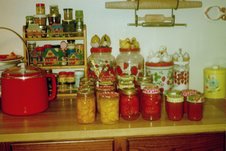TiPs for handling and cooking chicken
1. Don't rinse the chicken - that just spreads bacteria. You can pat it dry with towels (paper or clean cloth).
2. If you use a plastic cutting board, sanitize it afterwards in a dishwasher. Wood can be hand washed with a sanitizing solution (I prefer vinegar and salt to bleach).
3. Wash your hands well and often; be careful to clean under fingernails. Using plastic gloves works too.
4. The USDA recommended temperature for cooked chicken has been revised to 165°. (It used to be higher.)
5. Use an instant-read thermometer - you can't tell if it's done just by looking. You might want to check the temperature in more than one location, such as the thickest part of the thigh and breast, being careful not to touch bone.
6. When buying poultry, check the sell-by date and buy the one farthest out.
7. Cook within 2 days of buying, regardless of sell-by date. Home refrigerators are warmer than store fridges.
8. Save the scraps - bones, trimmings, giblets. You can add them to a freezer bag and freeze to make broth later.*
9. Save the fat! It's healthier than you may think - high in helpful fats and low in polyunsaturated fats.
10. Cook at a moderate temperature - high temperature or broiling can dry it out and cook unevenly (too done/dry outside, not done inside.)
*to make broth:
· Put the bones** and scraps in a pot (a crockpot works well) and cover with water.
· Add some onion, carrot, celery, herbs (thyme, bay leaf, sage).
· Turn the heat to "low" and bring SLOWLY to a simmer. (DO NOT BOIL or it will turn cloudy and muddy-looking.)
· Cover and simmer for 2 to 6 hours.
· Strain the broth through a fine sieve or cheese-cloth lined colander.
· Discard the scraps and the vegetables.
· Season the broth to taste with salt.
· Pour the broth into containers (such as quart size yogurt tubs or wide-mouth canning jars).
· Chill the strained broth in the fridge for 12 - 24 hours.
· When chilled, the fat will rise to the top and form a solid layer that is easy to remove.
· Save the fat***! You can store it in small 1/2 cup containers and freeze.
· If the broth is solid (jelled) when chilled, that is a good thing! It means it is full of protein and flavor!
· You can use the broth right away or freeze. Freeze in 1 cup containers for ease of use.
· To make soup - add cooked vegetables, rice, noodles, lemon juice, ginger, etc. and heat.
**An option: To give the broth a darker, roasty flavor, roast the bones in a 350° oven for 30 minutes before making broth.

No comments:
Post a Comment